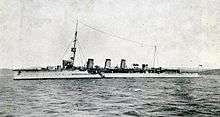Blas de Lezo-class cruiser
The Blas de Lezo-class cruisers were a group of two cruisers built for the Spanish Navy in the 1920s. The ships were ordered in 1915 but construction proceeded slowly due to materials shortages during World War I. The ships were built by Sociedad Española de Construcción Naval in Ferrol and showed considerable British design influence, resembling contemporary British C-class cruisers.
.jpg) Méndez Núñez after her 1944 refit | |
| Class overview | |
|---|---|
| Name: | Blas de Lezo class |
| Builders: | Sociedad Española de Construcción Naval in Ferrol |
| Operators: |
|
| Preceded by: | Navarra |
| Succeeded by: | Almirante Cervera-class cruiser |
| In commission: | 1924–1963 |
| Completed: | 2 |
| Lost: | 1 |
| Retired: | 1 |
| General characteristics | |
| Displacement: |
|
| Length: | 462 ft (141 m) |
| Beam: | 46 ft (14 m) |
| Draught: | 14 ft 4 in (4.37 m) |
| Propulsion: | 4 shafts, Parsons Type geared turbines, 12 Yarrow Type boilers, 45,000 hp |
| Speed: | 29 knots (54 km/h) |
| Range: | 5,000 nmi (9,300 km) at 13 kn (24 km/h) |
| Complement: | 320 |
| Armament: |
|
| Armour: | 3 - 2 inch belt, 1 inch deck, 6 inch conning tower |
Mendez Nunez was reconstructed into an anti-aircraft cruiser in 1944. She was re-armed with 8 - 120mm Vickers anti-aircraft guns in single mountings, 4 × 2 37mm and 2 × 4 20mm light AA guns of German origin. The superstructure was completely rebuilt and fitted with modern fire control equipment. Two triple banks of torpedo tubes were retained.
Ships
| Ship | Launched | Commissioned | Fate |
|---|---|---|---|
| Blas de Lezo | 27 July 1922 | March 1925 | Wrecked 11 July 1932 |
| Méndez Núñez | 3 March 1923 | 1924 | Stricken 1963 |
Blaz de Lezo

Blas de Lezo was named after Admiral Blas de Lezo. In early 1926, she supported the transatlantic flight from Spain to Buenos Aires, Argentina, of a four-man Spanish Air Force crew led by pilot Major Ramón Franco – the brother of future Spanish caudillo Francisco Franco – and including copilot/navigator Captain Julio Ruiz de Alda Miqueleiz in the Dornier Do J Wal ("Whale") flying boat Plus Ultra ("Farther Still"), carrying spares and other equipment for the flight.[1] She struck a rock near Cape Finisterre in 1932 and sank in deep water.
Méndez Núñez
Méndez Núñez was named after Admiral Casto Méndez Núñez. She was based in Equatorial Guinea at the start of the Spanish Civil War and she returned home to fight for the Spanish Republican Navy. In 1939, following the Cartagena Uprising, she was interned in Bizerte and seized by the French authorities. She was later handed to Francoist Spain, serving until 1963.
References
- O'Connor, Derek, "The Other Franco," Aviation History, January 2018, p. 57.
Bibliography
- Chesneau, Roger, ed. (1980). Conway's All the World's Fighting Ships 1922–1946. New York: Mayflower Books. ISBN 0-8317-0303-2.
- Whitley, M. J. (1995). Cruisers of World War Two: An International Encyclopedia. London: Cassell. ISBN 1-86019-874-0.
External links
| Wikimedia Commons has media related to Blas de Lezo class cruiser. |